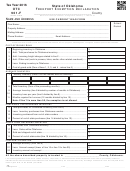Access IRS Tax Forms. Complete, Edit or Print Tax Forms Instantly. See all full list on irs. The transfer of the dependency exemption to the noncustodial parent could be for one year or any number of future years.
It was up to the parents to decide. They default to the custodial parent, which granted is not always apparent, but usually is. If the non-custodial parent wants. The old dependency exemption used to be worth about $0for each qualifying child. However, changes to the law means that these have been eliminated.
An individual is not a dependent of a person if that person is not required to file an income tax return and either does not file an income tax return or files an income tax return solely to claim a refund of estimated or withheld taxes. For example, the following tax benefits may all be associated with a dependent : child tax credit, additional child tax credit, credit for other dependents , earned income credit, child and dependent care credit, head of household filing status, and other tax benefits. You can claim an exemption for yourself, your spouse, and each of your dependents. Federal tax law is what determines who may claim a dependency exemption for a child.
Even if a state court order allocates a child’s dependency exemption to a noncustodial parent, the noncustodial parent must comply with the federal tax law to claim the exemption. There are two main types of exemptions : personal exemptions and exemptions for dependents. These exemptions lower the amount of your income that is subject to tax, which in turn, reduces the amount of tax you owe.
Start Your FREE E-file. For parents that are together and file their taxes jointly, there is no controversy as far as the dependency exemptions and deductions are concerne as their child is seen as the dependent of both of them. The dependent exemption reduces the amount of income on which you will be taxed (in effect, an exemption operates the same as a deduction).
The right to claim exemptions , however, phases out at higher income levels. Probably the biggest change is that you no longer have dependency exemptions. No exemptions for your children. What parents cannot do is change their tax filing status. Dependency Exemptions and Filing Status.
Many people mistakenly believe that filing taxes as Single or Head of Household can be interchanged with the dependency exemptions. While parents can reallocate dependency exemptions , they cannot exchange the Head of Household tax filing status. An exemption will directly reduce your income. A credit will reduce your tax liability. A dependent exemption is the income you can exclude from taxable income for each of your dependents.
For every child that you’re able to claim the exemption , you will need to include each child’s Social Security number on your tax return. You can take an exemption deduction for yourself, your spouse and each dependent you claim. New tax provisions, including a higher standard deduction, may or may not make up for the removal of personal and dependent exemptions , as taxpayers’ situations vary. In addition to the exemptions above, you may qualify for a “hardship” exemption. Hardships are life situations that keep you from getting health insurance.
To claim a hardship exemption , you must. The exemption amount has been increased to $150. As you can see, these amounts can soon add up if you have a few dependents in your family. The new tax law eliminated personal exemptions , but having dependents can still save you a lot of money if you claim these deductions and credits. Claiming dependents can help you save thousands of dollars on your taxes.
Yet many of us are not aware of who in our family may qualify as our dependent. Review the rules for claiming dependents here for a qualifying child or relative.



No comments:
Post a Comment
Note: Only a member of this blog may post a comment.